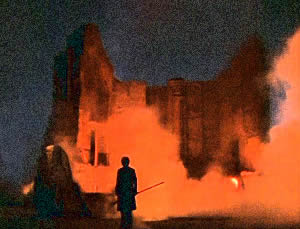
 |
The 1976 Bayreuth Centenary Ring Frenchman Patrice Chéreau was not Wolfgang Wagner's first choice to direct the landmark centenary production of Der Ring des Nibelungen in 1976 at Bayreuth. Ingmar Bergman, Sir Peter Brook, and Peter Stein were all offered the monumental task first, and all turned it down. Pierre Boulez, who had already been hired to conduct, suggested the relatively unknown Chéreau to Wagner. The director had had very little experience with opera, and his sole contact with the works of Richard Wagner was to have slept through a performance of Die Walküre at the Paris Opéra. Needless to say, he got the job. This production of the Ring revolutionized the staging of opera around the world, and it shocked the old-guard in the same way that Wieland Wagner's post-war Parsifal did back in 1951. |
Chéreau selected Richard Peduzzi as his scenic designer, and Jacques Schmidt to design the costumes. Neither of them had ever attended a performance of a Wagner opera. With the artistic team in place, and a cast featuring the most accomplished singers of the day (Gwyneth Jones as Brünnhilde, Donald McIntyre as Wotan, Peter Hofmann as Siegmund) Chéreau and his colleagues began to dissect the one hundred year old work in order to make it relevant to a modern audience. The greatest aspect of this production was that the director was approaching the work with absolutely no preconceived notions and, as a result, focused on unexpected aspects of the music drama. The acting, for instance, ended up being superb. Never before in the history of Bayreuth had stage direction been given such an importance. Chéreau delivered a Ring of shattering dramatic power focusing on the theme of power and its ability to corrupt. Some critics saw it as a Marxist Ring, while others viewed it as a mere reworking of George Bernard Shaw's ideas in The Perfect Wagnerite. |
 |
It was, without a doubt, the most erotic Ring that had ever been mounted at Bayreuth. At the end of Act I of Die Walküre, Peter Hofmann, in the role of Siegmund, made love to his sister Sieglinde, played by Jeannine Altmeyer, with such passion that in the words of author Frederic Spotts the scene "almost qualified for an X-rating." Later in Act II, the tenor took off his shirt when Brünnhilde, played by Gwyneth Jones, prepared his body for death. Likewise, the end of Siegfried featured a similar passionate moment between the tile character and the newly-awakened Brünnhilde, as the young hero finds out just how much this maiden is not a man. Obviously this sexual openness shocked the very conservative opening night crowds. But it was the settings, costumes, and the new concept of this Ring that truly brought the most discontent that summer. The first scene of Das Rheingold opened not on the banks of the river Rhine, but on a huge hydro-electric plant, with Rhinemaidens that were nothing more than streetwalkers out to swindle Alberich. Act II of Die Walüre featured Wotan dressed in a morning coat and spear, while Valhalla resembled more a classical palazzo with a gigantic pendulum swinging from the ceiling. In Siegfried. Fafner was a gigantic 19th century toy-dragon wheeled about by stagehands, and Mime carried with him a small, battered suitcase. But it was the final evening, Götterdämmerung, that featured the most controversial and exciting ideas. The hall of the Gibichungs had classical columns, and stood by the banks of what appeared to be the Hudson River. By the river stood a row of deserted tenements that resembled those of New York's dockland. In this curious place, Gunther always dressed in a tuxedo, and just as incongruously, Gutrune sported an expensive couture dress. Surrounded by his men, who carried submachine guns, Hagen was an ill-shaven lout who dressed in a rumpled suit. |
 |
The old-guard felt that this was truly an outrage. The music critic from the Observer noted that he "had not previously experienced in the theater protest as furious as that which greeted Das Rheingold. But it paled before what was to come." He added that the opening night of Götterdämmerung "contributed to a pandemonium that twice nearly brought the performance to a halt." Further, "when the producers... bravely presented themselves on the stage alongside the conductor... they were greeted by a sustained howl of rage." Also, the orchestra revolted against what they sensed was Boulez's lack of knowledge of the work. When his interpretation favored the suppression of leitmotifs, three-quarters of the players publicly disavowed the conductor and refused to appear with him at the conclusion of the first performance. Meanwhile, in the audience bloody fights broke out between supporters and critics. Wolfgang Wagner's wife' had her dress ripped, and another woman had her earring torn off, and the earlobe with it. |

One of the most remarkable moments in Patrice Chéreau's Ring occurs in Act III of Götterdämmerung. Siegfried has been killed by Hagen, and the orchestra begins the music that is commonly known as "Siegfried's Funeral March." The chorus silently assembles by the apron of the stage. Wagner's stage directions call for a funeral procession at this point, but in this production a crowd of working class people simply stare at the audience with mute expressions of hopelessness. |
 |
 |
 |
 |
Production: Patrice Chéreau |
Scenic Designer: Richard Peduzzi |
Costume Designer: Jacques Schmidt |
Conductor: Pierre Boulez |
Buy the DVD of this production by clicking here |
